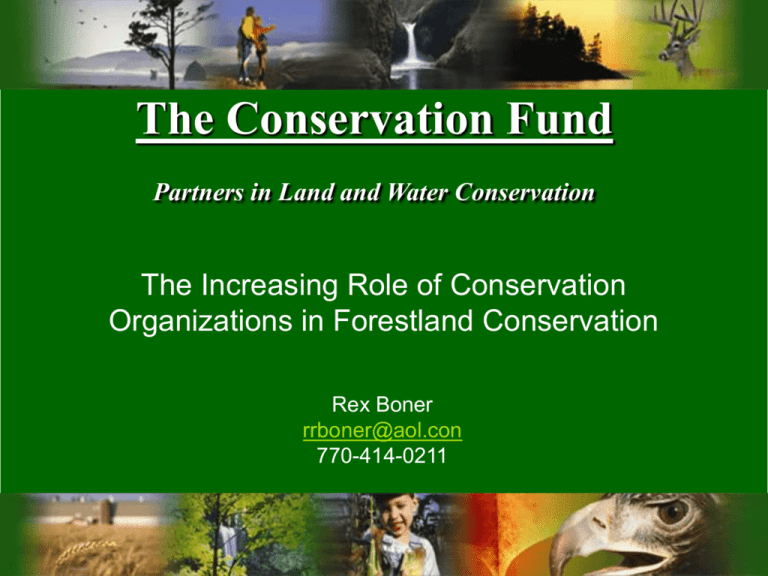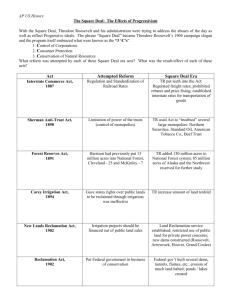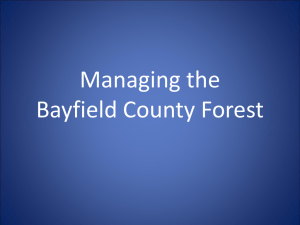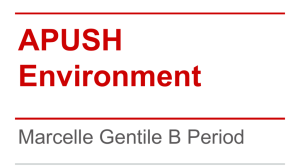
The Conservation Fund
Partners in Land and Water Conservation
The Increasing Role of Conservation
Organizations in Forestland Conservation
Rex Boner
rrboner@aol.con
770-414-0211
Conservation Mission
The Conservation Fund forges partnerships to
conserve America’s legacy of land and water
resources. Through land acquisition, sustainable
programs, and leadership training, the Fund and its
partners demonstrate sustainable conservation
solutions emphasizing the integration of economic
and environmental goals.
Conservation Results
Acres Protected Since 1985: 5.4 Million
Fair Market Value: $2.9 Billion
Purchase Price: $2.1 Billion
One of the Nation’s Top Rated Nonprofits
1% Fundraising Cost
96% Program Allocation
“A+” Grade for Unsurpassed Effectiveness and
Efficiency-American Institute of Philanthropy
“Four star” rating for exceeding industry
standards -Charity Navigator
Rated one of America’s Top 100 Charities
by Worth and Forbes Magazines
Partners in Conservation
Public Agencies
Foundations
Corporations
Nonprofits
Individuals
Conservation Programs
Land Conservation: Assists government agencies and
nonprofit organizations to acquire and conserve land across
the country.
Sustainable Programs: Demonstrates market-based solutions
for challenging environmental issues.
Leadership Training: Through courses, workshops and
seminars, serves as a national resource for land conservation
professionals.
Working Forests
Since 1985, the Fund has conserved more than
800,000 acres of working forests, including:
Champion Forest, NY, VT, NH
Edisto River, SC
Cumberland Forest, TN
Glatfelter Forest, MD
Middle Neches River, TX
Chesapeake Forest, MD, VA, DE
Adirondack State Forest, NY
Garcia River Forest, CA
Okefenokee, GA
300,000 acres
7,200 acres
75,000 acres
25,000 acres
33,000 acres
76,000 acres
257,000 acres
24,000 acres
16,000 acres
Results in Georgia
Through partnerships, over 60,000 acres have been
acquired to assure their continued natural value.
16,000 acres at Okefenokee donated by DuPont to TCF,
timber and recreation rights reserved by International Paper,
timber sustainably managed
Over 15,000 acres in the East Gulf Coastal Plain at the
Georgia-Florida border in partnership with Doris Duke
Charitable Foundation, Tall Timbers Research Station, others
With GFC, TCF protected 2,500 acres at Callaway Gardens
through the first Forest Legacy Conservation Easement in
Georiga.
Importance of Forestlands in Georgia
Functioning Ecological Systems
Watershed Protection
Water Quality
Air Quality
Wildlife Habitat
Recreation
Quality of Life
Forest Products
Economic Impacts
Threats to forestland:
Growing population and development pressure
Rising Value of land
Property taxes based on “highest and best” use
Disposition of Industrial timberland tracts
Fragmentation
Loss of markets and competing markets
© 2004 R.B. Hammer and V.C. Radeloff
Project conducted by Roger B. Hammer
and Volker C. Radeloff at the University of
Wisconsin-Madison
For more information contact Volker C.
Radeloff at:
– radeloff@wisc.edu
– 608-263-4349
Forests are the dominant land use in the south
215 million acres
Where we face conversion is where it hurts the most
60 % of the nation’s and 18% of the world’s industrial
roundwood output
Over 1.5 million jobs
billions of dollars to the South’s economy
(SFRP)
http://sfrponline.net/
Changes in Ownership in the South
From 1980 to 2000, 28 million acres (13%) of Southern
forest changed hands (SFRP)
From 1996 to 2004, 18 million acres of Southern forest
passed out of industry ownership (SFRP)
88% of forests are in private ownership
59% are family-owned forests
Forest Service researchers forecast an additional net loss
of 23 million acres of forest land by 2050
Georgia
24.2 million total acres of
forest
22.3 million acres, 92% is
in private ownership
Once sold, large
forestlands often become
fragmented and often
converted to non-forest
uses
What this means for the future of
Working Forests
Collaboration is needed!
• Traditional
• Non-traditional
Important role for public lands
Important role for private lands
The Upside
Many opportunities among challenges
Diverse conservation tools
Vast opportunities for collaboration
Public land protection continuing
Expanding conservation activities with private
landowners
A growing pool of environmental supporters
Copyright 2004 – The Conservation Fund
Methods for Conserving Forestland
Fee Simple- the outright purchase of land including the
title and the rights.
- Often utilized by public agencies
Conservation Easements- conveys specific land rights to
another party
- Voluntary and permanent legal agreement between a landowner
and a qualified organization
- Landowner retains ownership and many uses of the property
- Appropriate tool for private landowners
Other less than fee simple transactions
Champion Northern Forest
New York, New Hampshire, Vermont
300,000 acres, $76 million in 1999
1st large implementation of working forest
easement and ecological preservation in a
market transaction in multiple states
Transferred most ecologically sensitive areas to
public ownership and sold remaining forestland
to private forest investors subject to
conservation easement.
Chesapeake Forest
DE, MD, VA
76,000 acres, $44 million in 1999
collaboration with a TIMO
Hancock Timber Resource Group, the State of
Maryland and the Richard King Mellon Foundation
sustainable forest plan for 30,000 acres on
Maryland’s Eastern Shore
balance of objectives – protecting wildlife habitat,
enhancing water quality and fostering sustainable
economic development
Cumberland Forest
Eastern Tennessee
75,000 acres, $ 10 million in 2002
First large use of divided surface rights and timber rights.
TCF bought the surface estate and transferred it to State of
Tennessee to be managed as a wildlife management area
Another party bought the timber rights
Shared-Use Agreement directs management of property
Timber management must meet BMP and SFI standards; extra
wide SMZ’s
TCF Owned Forestlands
Management of 64,000 acres of working forest:
10,000 acres in Eastern North Carolina at the
Palmetto-Peartree Preserve
– Red Cockaded Woodpecker mitigation bank for
NCDOT
– Active timber harvesting and ecotourism program
9,000 acres in Virginia
– Active timber harvesting and watershed protection
Carbon Sequestration:
From Fallow Fields to Fertile Forests
TCF in cooperation with several partners has protected
24,000 acres through our carbon sequestration program
Partners include:
Entergy (Red River NWR, LA)
Detroit Edison (Red River NWR, LA)
Chevron Texaco (Lower Mississippi River Valley)
American Electric Power (Catahoula NWR, LA)
Reliant Energy (Old Sabine Bottom WMA, TX)
Cinergy (Obion Creek WMA, KY)
PowerTree Carbon Company (Lower Mississippi River Valley)
Many opportunities here: help us expand this effective program
What made these projects successful?
•Compelling arguments for funding (function of conservation
values and political\context)
•Collaboration with private investment partners
•Price and funding leverage; all included state funds
•Willingness to compromise and creativity in developing
protection strategies
•Understanding of resource management issues
•Ability to complete complex transactions
General Principles for Successful
Landscape Scale Sustainable Forestry
Seek common ground; focus on areas of agreement
Seek permanent protection of working forestlands
Seek partnerships, including non-traditional partners
Consider non-timber values and importance of forestlands
Keep large forestland tracts intact
Be open-minded and creative; split legal interests will
continue to be one model to pursue
General Principles for Successful
Landscape Scale Sustainable Forestry
Focus on connectivity and watersheds
Real Estate keys are location, location, location
Sustainable forestry keys are collaboration, collaboration,
collaboration
Involve local communities
• They are the beneficiaries of the jobs, water quality
protection, wildlife habitat, etc; they need to better
understand and support sustainable forestry
As forestlands are lost, everyone loses - foresters, treehuggers and wildlife
Questions ?
Rex R. Boner
The Conservation Fund
770-414-0211
rrboner@aol.com








